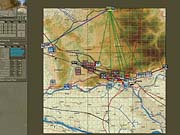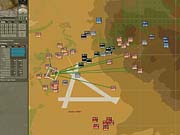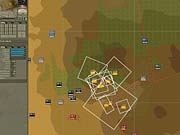Airborne Assault: Red Devils Over Arnhem is based on an ideal subject for a wargame. It centers on a battle with a lot of mobility, clearly defined objectives, and unique challenges for both sides. Couple this with Australian developer Panther Games' innovative gameplay system and you have one of the best single-battle wargames since Atomic Games' V for Victory series.

Airborne Assault is based on the World War II battle Operation Market Garden, an ambitious Allied scheme to drop paratroopers into Holland. The Allies' objective was to secure a crossing over the Rhine into Germany, thereby doing an end run around the logistical problems facing the Allied advance through France. If it had worked, it likely would have ended the war much sooner. The plan was for the 1st Airborne Division to land near Arnhem and secure the bridge there for the advancing 30th Corps. But for various reasons, including the 30th being delayed, the unexpected presence of two SS Panzer divisions, and a quick German response, the 1st Airborne Division was decimated and the 30th Corps served only to extract the survivors. Operation Market Garden was a spectacular failure.
The battle for Arnhem is an exciting subject for a wargame for a few reasons. Because the Allied troops arrived by parachutes and gliders, they began the encounter scattered out. The early stages of the battle involved the Allies gathering and positioning their forces for a drive on the objective, while the Germans were trying to find and disrupt them. While the Allies were using highly trained troops, they had no access to heavy weaponry. The Germans, on the other hand, had armored vehicles and artillery, but they were initially limited to whatever troops happened to be in the area. As the battle progressed (it lasted 10 days), both sides poured in reinforcements. It was a dynamic situation with plenty of opportunity for maneuvering and surprises.
Panther Games' new gameplay system does an excellent job of combining detail with ease of use. The action runs in real time (and gives you the option to pause the game), but the amount of information available is more than what you get in most turn-based games. Units are displayed with the conventional markers, or "chits," you've come to expect in a wargame, generally representing individual companies, their headquarters, or support units like artillery or armored assets. A variety of hotkeys lets you quickly display different types of information on the chits, such as facing, firepower, or morale. Enemy chits show information depending on your intelligence, along with an indication of how current and reliable that information is. A sidebar provides specific information on things like cohesion, fatigue, and the number of men, vehicles, and guns in each squad. There's even information available on which weapons and vehicles a unit is equipped with. You can see how many Tiger tanks are in a Panzer division or that a British paratrooper company has 85 Lee Enfield .303s, 33 Stens, 10 Brens, four PIAT antitank weapons, three 2-inch mortars, and a Vickers machine gun.

However, Panther Games didn't just dump a bunch of data into Airborne Assault. When you select a unit's headquarters, there's a tab that displays the unit's historical information. This lets you read about a unit's background and its contribution to the battle. These snippets of history provide an excellent sense of how the Germans had to scrape together whatever troops they could, from hardened veterans of the eastern front who happened to be refitting in the area to young untrained soldiers, Luftwaffe personnel, and tanker and artillery crews with no equipment to man. This is an excellent way to breathe life into what would otherwise be sterile, faceless scraps of data. Hopefully, more wargames will take this approach in the future.
Airborne Assault is also notable for being much more intuitive than most chit-based wargames. When you select a unit, a white box is drawn on the map to display the actual area the unit is deployed across. Drag-selecting a bunch of chits will give you a clear picture of where the soldiers in those units are actually located. You can manually change the area of deployment, although there's not much point fiddling with these settings, as the AI does a good job of managing units for you.

The way the AI manages the gameplay is probably the most innovative thing about Airborne Assault. Looking at screenshots, you'd guess that it plays like any chit-based wargame, in which you move your units, give them firing orders, and let the algorithms manage the results. But Airborne Assault is nothing like this. Instead, it focuses on the organization of the troops and lets you use this organization to carry out your strategy. Command structures among units are clearly displayed with colored lines, making it easy to select headquarters units and see the relationships between the various units. You can even use the cursor keys to quickly move through the command hierarchy: Press up or down to move to the next level of the hierarchy and left and right to move among different units within the current level. It's a brilliant way to make the complexities of military organization easily understood and accessible.
This is particularly important since you don't play Airborne Assault by moving each chit yourself. Instead, you give a commanding unit an order and a waypoint, and it then uses the units under its command to carry out your orders. As time passes (you can pause at any time or have the game run at one of three different speeds), you can watch entire regiments working together as an organization. You'll see them form up before moving toward their objective, leave reserves and support units in the rear, and arrange themselves to cover their flanks and use terrain. Your units will use roads to move through secure areas, and they'll call for artillery strikes as they advance. You can select any unit and see the path it's going to take to get to its objective.
At any time, you can jump in and take control of as few or as many of the units as you want. Although the AI is reliable enough that this isn't normally necessary, it can be useful to detach a small group to scout, secure an area, or delay enemy attackers. Colored lines clearly show who's firing what at whom. Although there aren't many sound effects, the graphics are sharp and functional, clearly presenting a maximum amount of information without being cluttered. The result is a refreshing game system that's free of micromanagement, but not at the expense of detail.
There are occasions when it's not always clear what's going on. For instance, it seems like some units rest at night and others don't. So it might not be obvious if you're not watching the clock why your men aren't doing what you've told them to do. But even then, there are still times when you'll want someone to go somewhere and he instead dawdles for some reason. Panther Games is working on a patch to incorporate command delays, which will certainly add a nice bit of realism but might also add some new confusion.
Otherwise, the most significant criticism you could direct at Airborne Assault is that because it only covers a single battle, it may not have much replay value for anyone with only a casual interest in the subject matter. Random drop zones for the Allies give the game some replay value. You can also choose smaller scenarios or the full 10-day battle, but they all take place on the same fairly small map, which is centered on the Arnhem road bridge over the Rhine. There are variables that let you explore various "what ifs." What if the 30th Corps hadn't been delayed? What if more men had been dropped in on the first day? What if the Allies had secured the airfield north of Arnhem so they could airlift in reinforcements? As it is, Airborne Assault clearly shows the challenge the Allies faced, and many of these variables help make the game more balanced for multiplayer games.

Finally, Airborne Assault has to be commended for its superlative documentation. It comes with a thick manual brimming with historical background, information on the how the game system works, and strategy tips. There are thorough tables for terrain and formation effects, as well as a detailed order of battle for both sides. There's even an index. The manual does have some peculiarities, such as abbreviating "company" as "coy," referring to drag-selecting as "marquee selecting," and calling an appendix an "annex." With a manual this good, we can forgive those wacky Australians their idioms.
In scale and design, Airborne Assault recalls Atomic's old V for Victory series. In gameplay and pacing, it resembles Atomic's Close Combat series. On the whole, this is a must-have for anyone who wants to see how the genre can move beyond the conventions of turn-based, chit-based wargaming.